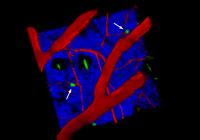
These is a false color image of the skin showing newly discovered immune cells, which have a potential link to allergic skin diseases like eczema. Sydney researchers have discovered a new type of immune cell in skin that plays a role in fighting off parasitic invaders such as ticks, mites, and worms, and could be linked to eczema and allergic skin diseases.
The team from the Immune Imaging and T cell Laboratories at the Centenary Institute worked with colleagues from SA Pathology in Adelaide, the Malaghan Institute in Wellington, New Zealand and the USA.
The new cell type is part of a family known as group 2 innate lymphoid cells (ILC2) which was discovered less than five years ago in the gut and the lung, where it has been linked to asthma. But this is the first time such cells have been found in the skin, and they are relatively more numerous there.
"Our data show that these skin ILC2 cells can likely supress or stimulate inflammation under different conditions," says Dr Ben Roediger, a research officer in the Immune Imaging Laboratory at Centenary headed by Professor Wolfgang Weninger. "They also suggest a potential link to allergic skin diseases."
The findings have been published today in the respected journal Nature Immunology.
"There's a great deal we don't understand about the debilitating skin conditions of allergies and eczema," says Professor Weninger, "but they affect hundreds of millions of people worldwide. Dermal ILC2 cells could be the clue we need to start unravelling the causes of these diseases."
The Weninger lab, which has developed techniques for marking different cells of the immune system and tracking them live under the microscope, actually discovered the new dermal cells some years back. "We just didn't know what they were," Roediger says.
The Centenary researchers, however, suspected they might be associated with type 2 immunity, the part of the immune system that deals with infection by parasitic organisms. So they contacted Professor Graham Le Gros at the Malaghan Institute, one of the world's foremost researchers into type 2 immunity.
Not only did Professor Le Gros and his team confirm that the Centenary researchers had found a new form of ILC2 cell, but they were able to provide a new strain of mouse developed in the USA that provided insight into the function of these cells.
"Using these mice, we found that ILC2 cells were the major population in the skin that produced interleukin 13, a molecule that has been linked to a number of allergic diseases, including eczema." Roediger says.
Using their sophisticated live imaging techniques, the Centenary researchers were also able to watch the behaviour of the ILC2 cells in the skin, where they moved in a characteristic way—in random spurts punctuated by stoppages.
"A halt in movement usually indicates some sort of interaction with another cell," Roediger says. In this case, the ILC2 cells always seemed to stop in close proximity to mast cells, which are known to play a key role in controlling parasitic infections and to be associated with allergies.
As well as the interaction with mast cells, the Centenary team were able to show that ILC2 cells could be stimulated to spread quickly and were capable of generating the inflammatory skin disease.
"We now have experiments underway in which we are actively looking for the direct involvement of these cells in the sort of skin diseases you would predict based on these findings," says Roediger.
Source : toni@scienceinpublic.com.au
 Print Article
Print Article Mail to a Friend
Mail to a Friend
